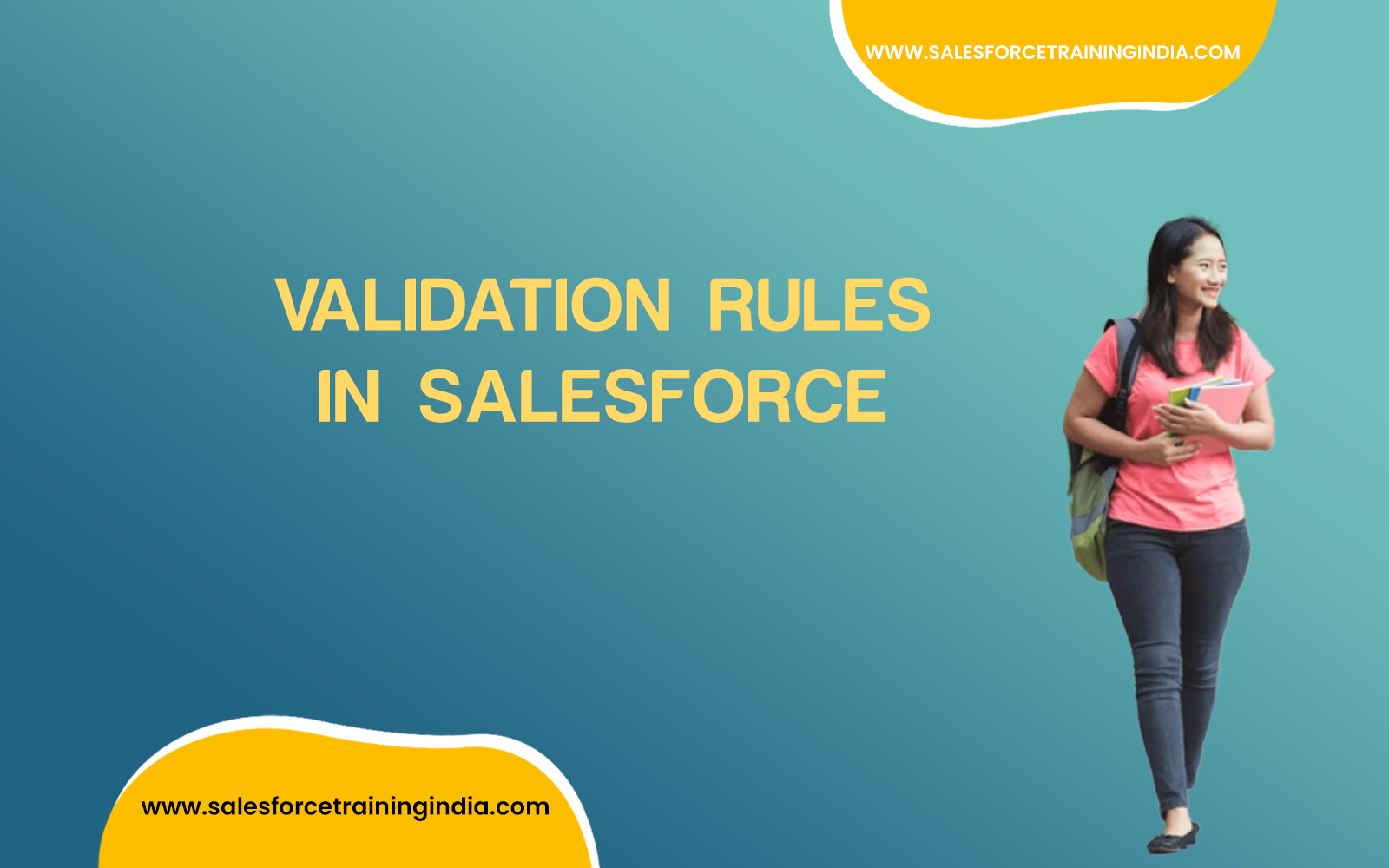Validation Rules
Validation rules in Salesforce are critical for maintaining data quality and integrity. They are formulas or expressions that evaluate the data a user enters into a record. When a user tries to save a record, the validation rule checks the data against the criteria defined in the rule. If the data doesn’t meet the criteria, the record isn’t saved, and Salesforce displays a customized error message to the user, guiding them to correct the information.
Usage
These rules ensure that data entered into Salesforce adheres to specific standards, formats, or business processes that an organization requires. For example, a validation rule can ensure that a required field isn’t left blank, a numerical value falls within a certain range, or a date entered is within a specific timeframe. By preventing incorrect or incomplete data from being saved, validation rules uphold data accuracy and prevent potential issues down the line, thus supporting effective and reliable data management within Salesforce.
Frequently Asked Questions
1. What are validation rules in Salesforce with examples?
Validation rules in Salesforce are used to ensure that data entered into Salesforce records meets specific criteria before the record can be saved. These rules enforce data integrity and accuracy by evaluating the data entered and preventing the save operation if the data does not meet the specified conditions. For example, a validation rule can ensure that the “Close Date” of an opportunity is not set to a past date, thereby maintaining the accuracy of the sales pipeline.
Example:
ISCHANGED(CloseDate) && CloseDate < TODAY()
This validation rule checks if the “Close Date” has been changed to a date earlier than today and prevents the record from being saved if the condition is true.
2. What are the three validation rules?
When discussing validation rules in Salesforce, it typically refers to the specific criteria set within the rules to enforce data quality. However, in a broader context, the three common types of validation rules include:
- Field-Level Validation: Ensures data entered in a specific field meets the defined criteria.
- Record-Level Validation: Checks conditions across multiple fields within a single record.
- Cross-Object Validation: Validates data based on related records or other objects.
These rules work together to maintain high data quality and integrity within the Salesforce database.
3. What is the best practice for validation rule in Salesforce?
Best practices for validation rules in Salesforce include defining clear and concise conditions to ensure data integrity without overly restricting user inputs. Use descriptive error messages that guide users to correct the data entry. Always test validation rules in a sandbox environment before deploying them to production to avoid disrupting business operations. Additionally, consider the impact on integrations and data imports; ensure that validation rules do not hinder necessary data processing. Regularly review and update validation rules to align with evolving business requirements and data quality standards.
4. How many validation rules can we create in Salesforce?
The number of validation rules you can create in Salesforce depends on the edition of your Salesforce instance. In general, Salesforce allows for up to 500 validation rules per object. This limit ensures that you can enforce data integrity across various fields and objects without compromising system performance. It’s important to use these rules judiciously to maintain a balance between enforcing data quality and providing a seamless user experience.
5. What is the max validation rule in Salesforce?
The maximum number of validation rules you can create per object in Salesforce is 500. This limit is set to ensure optimal performance and manageability within the platform. While having a large number of validation rules can enhance data quality, it’s crucial to design them efficiently to avoid unnecessary complexity and potential performance issues. Regularly reviewing and optimizing your validation rules can help maintain a robust and efficient data validation framework within your Salesforce environment.
6. What are the limitations of validation rules?
Validation rules in Salesforce come with certain limitations that users need to be aware of to ensure proper implementation and functionality. One key limitation is that validation rules cannot reference encrypted fields, which restricts their use in scenarios involving sensitive data that needs encryption. Additionally, validation rules cannot be bypassed by standard user permissions, meaning they apply universally to all users, which can sometimes hinder specific administrative tasks or data migrations. Another limitation is the 500 validation rules per object limit, which, while generous, requires careful management in large and complex implementations. Finally, validation rules can impact data imports and integrations, as any data that does not meet the validation criteria will be rejected, potentially disrupting automated processes.
7. What are the advantages of validation rules in Salesforce?
Validation rules in Salesforce offer numerous advantages, significantly enhancing data integrity and quality within the platform. One of the primary benefits is their ability to enforce consistent data entry standards, ensuring that all records meet predefined criteria before being saved. This reduces the risk of errors and inconsistencies in the database. Validation rules also provide real-time feedback to users during data entry, helping them correct mistakes immediately and reducing the need for extensive data cleanup later. Moreover, they support custom business logic tailored to specific organizational needs, ensuring that critical business requirements are met. Overall, validation rules help maintain a high level of data accuracy and reliability, which is essential for effective decision-making and reporting.
8. Can we bypass validation rules in Salesforce?
In general, validation rules in Salesforce cannot be bypassed during normal data entry processes by standard users, as they are designed to enforce strict data quality standards. However, there are specific scenarios where validation rules can be temporarily bypassed. For instance, during data imports or data migration, administrators can use tools like Data Loader or API integrations with the “allOrNone” parameter set to false, which allows partial imports even if some records fail validation. Additionally, workflow rules, process builder, and Apex triggers can sometimes be configured to bypass validation rules under certain conditions. It’s important to carefully manage and document these exceptions to ensure they don’t compromise overall data integrity.
9. How to use if in validation rule Salesforce?
To use the IF function in a validation rule in Salesforce, you can incorporate conditional logic to check whether specific criteria are met. The IF function evaluates a condition and returns one value if the condition is true and another value if it is false. This can be useful for creating more complex validation rules that depend on multiple conditions. For example, the following validation rule ensures that a custom field “Discount” is only populated if the “Status” field is set to “Approved”:
IF(Status = "Approved", ISBLANK(Discount), true)
In this example, the rule checks if the Status field equals “Approved.” If true, it then checks if the Discount field is blank. If the condition is not met, the rule prevents the record from being saved.
10. What are the 4 types of validation?
In the context of data management and software applications, there are four main types of validation typically referenced:
- Field-Level Validation: Ensures that data entered in individual fields meets specific criteria before being accepted. This is commonly used to enforce format, length, and value range requirements for single fields.
- Record-Level Validation: Checks the consistency and logic of data across multiple fields within a single record. This ensures that the data collectively makes sense and adheres to business rules.
- Cross-Object Validation: Validates data by comparing and checking fields from different but related objects, ensuring data integrity across relationships and dependencies.
- System-Level Validation: Includes broader checks across the entire system or database, often involving automated scripts or processes that validate data integrity and consistency on a large scale.
11. How to use picklist field in validation rule in Salesforce?
To use a picklist field in a validation rule in Salesforce, you need to reference the selected value of the picklist and define the conditions under which the rule should trigger. Validation rules can ensure that specific picklist values are selected only when other criteria are met. For instance, if you want to enforce that the “Priority” picklist field should only be set to “High” when the “Status” field is “Open”, you can write a validation rule like this:
AND(
ISPICKVAL(Priority, "High"),
NOT(ISPICKVAL(Status, "Open"))
)
In this example, the ISPICKVAL function checks if the “Priority” field value is “High” and if the “Status” field is not “Open”. If both conditions are true, the validation rule triggers, preventing the record from being saved. This ensures that high-priority tasks are only marked as such when they are open.
12. Can we use formula field in validation rule Salesforce?
Yes, you can use formula fields in validation rules in Salesforce. Formula fields can be referenced in validation rules to enforce data quality based on the calculated values they provide. By incorporating formula fields into your validation rules, you can create more dynamic and complex conditions. For example, if you have a formula field called “Total_Value” that calculates the sum of other fields, you can create a validation rule that checks if “Total_Value” exceeds a certain threshold:
Total_Value > 10000
In this case, the validation rule triggers if the calculated Total_Value exceeds 10,000, ensuring that certain actions are taken or restrictions are enforced based on the calculated result of the formula field. This integration enhances the capability of validation rules by leveraging the power of formulas.
13. How to deploy validation rules in Salesforce?
To deploy validation rules in Salesforce, you typically use the Change Sets feature, which allows you to transfer customizations from one Salesforce org to another, such as from a sandbox to a production environment. First, create and test your validation rules in a sandbox to ensure they work as expected. Once tested, add the validation rules to a change set by navigating to Setup > Change Sets. Create an outbound change set, add the validation rules, and upload the change set to the target environment. In the target environment, review and deploy the change set. This process ensures that your validation rules are correctly migrated and activated in the new environment, maintaining data integrity across different orgs.
14. Can we delete validation rules in Salesforce?
Yes, you can delete validation rules in Salesforce if they are no longer needed or relevant. To delete a validation rule, navigate to Setup, then go to Object Manager and select the object where the validation rule is defined. Under the Validation Rules section, locate the rule you wish to delete. Click on the validation rule to open its details and then click the Delete button. Confirm the deletion to remove the rule. Deleting unnecessary validation rules can help streamline your data management processes and ensure that only relevant rules are enforced, preventing potential conflicts and maintaining system efficiency.
15. What are triggers in Salesforce?
Triggers in Salesforce are pieces of Apex code that automatically execute before or after specific database operations, such as insertions, updates, or deletions of records. Triggers allow you to perform custom actions to enhance the default behavior of Salesforce. There are two types of triggers: before triggers and after triggers. Before triggers are used to update or validate record values before they are saved to the database, while after triggers are used to perform operations that require the record’s ID or to update related records. Triggers are essential for automating complex business processes, enforcing business rules, and ensuring data integrity within Salesforce. They provide a powerful way to extend Salesforce functionality beyond standard capabilities.
16. How many triggers can be created in Salesforce?
In Salesforce, you can create up to 3,000 Apex triggers per object. This limit is more than sufficient for most use cases, allowing you to implement a wide range of business logic and automation directly within the platform. However, best practices recommend consolidating related logic within fewer triggers to maintain readability and manageability. Instead of having multiple triggers for the same event on the same object, it is advisable to use trigger frameworks or handler classes to keep the code organized and efficient. This approach helps in avoiding conflicts and ensures that your triggers run smoothly without impacting performance.
17. When to use before trigger and after trigger?
Before triggers and after triggers in Salesforce are used for different purposes based on the timing of their execution relative to the database operation. Before triggers are executed before a record is saved to the database, making them ideal for scenarios where you need to validate data or modify record values before the actual insert, update, or delete operation. For example, you might use a before trigger to ensure that a required field is populated or to set a default value.
After triggers are executed after a record has been saved to the database. They are typically used for operations that require the record’s ID or involve actions on related records. For example, you might use an after trigger to update a related object or send an email notification based on the record’s data. Understanding the distinction between these triggers is crucial for implementing the correct logic and ensuring data integrity within your Salesforce environment.
18. What are triggers and flows in Salesforce?
Triggers and flows in Salesforce are both tools used to automate business processes, but they operate in different ways and are suited for different tasks. Triggers are pieces of Apex code that automatically execute before or after specific database operations like inserts, updates, or deletions. They are powerful and flexible, allowing developers to implement complex logic and interact with multiple objects.
Flows, on the other hand, are created using the Flow Builder, a point-and-click tool that allows you to design workflows visually. Flows can be used to automate processes, collect data, and perform actions like creating or updating records without writing code. While triggers are suited for more complex and programmatic logic, flows are ideal for automating business processes in a more user-friendly and declarative manner. Both tools are essential for customizing Salesforce to meet specific business needs, but choosing between them depends on the complexity and nature of the task at hand.
19. How many validation rules are there in Salesforce?
In Salesforce, the number of validation rules you can create per object is capped at 500. This limit ensures that users can enforce a comprehensive set of data quality rules while maintaining system performance. Validation rules are crucial for maintaining data integrity by ensuring that data entered into records meets predefined criteria. They help prevent errors and inconsistencies by validating the data before it is saved. While the 500-rule limit per object is generous, it encourages administrators to carefully plan and prioritize the most critical validation rules to ensure effective data management.
20. What is the purpose of validation rules in Salesforce?
The primary purpose of validation rules in Salesforce is to ensure data quality and integrity by enforcing specific criteria before a record can be saved. Validation rules check the data entered into fields against predefined conditions, preventing the saving of records that do not meet these criteria. This helps maintain consistent and accurate data within the Salesforce database. Validation rules are particularly useful for enforcing business rules, such as ensuring that required fields are populated, dates are within acceptable ranges, or values fall within specified limits. By implementing validation rules, organizations can reduce data entry errors, improve reporting accuracy, and ensure that their Salesforce environment remains reliable and effective for decision-making.
21. How to find validation rule in Salesforce?
To find validation rules in Salesforce, navigate to the Setup menu. In the Setup search bar, type and select Object Manager. Choose the object for which you want to view validation rules. Under the object’s settings, you will find a section labeled Validation Rules. Clicking on this section will display a list of all the validation rules defined for that particular object. Each rule can be clicked to view its detailed configuration, including the error condition formula and the error message. This interface allows you to manage, edit, and create new validation rules as needed.
22. How to use picklist value in validation rule?
To use a picklist value in a validation rule in Salesforce, you utilize the ISPICKVAL function. This function checks whether a specific picklist field contains a certain value. For example, if you want to enforce that a field should be empty when the picklist value is set to a specific option, you can write a validation rule like this:
ISPICKVAL(StageName, "Closed Lost") && ISBLANK(Reason_Lost__c)
In this example, the rule checks if the StageName picklist field is set to “Closed Lost” and if the Reason_Lost__c field is blank. If both conditions are true, the validation rule triggers, preventing the record from being saved until the required field is populated. This ensures data consistency and enforces specific business rules based on the picklist value.
23. How to use prior value in validation rule?
To use the prior value in a validation rule in Salesforce, you can reference the PRIORVALUE function. This function retrieves the previous value of a field before the current update. This is useful for creating rules that enforce conditions based on changes to field values. For example, if you want to prevent a status field from being changed back to its previous value, you could use a validation rule like this:
AND(
ISCHANGED(Status__c),
PRIORVALUE(Status__c) = "Approved",
Status__c <> "Pending"
)
In this example, the rule checks if the Status__c field has changed, and if its prior value was “Approved”, while ensuring the new value is not “Pending”. This prevents reverting the status to “Pending” once it has been set to “Approved”, ensuring that workflow rules and business processes are followed correctly.
24. What is the difference between validation rules and triggers?
The difference between validation rules and triggers in Salesforce lies in their purpose and complexity. Validation rules are declarative, meaning they are created using a point-and-click interface and simple formulas to enforce data integrity. They prevent users from saving invalid data based on specific conditions. Validation rules are straightforward and easy to implement, making them ideal for enforcing field-level and record-level data quality.
Triggers, on the other hand, are pieces of Apex code that execute before or after specific database operations, such as inserts, updates, or deletions. Triggers are used for more complex business logic that cannot be achieved through declarative means. They can perform operations across multiple records and objects, making them powerful but also requiring programming knowledge. While validation rules are limited to data validation, triggers can automate a wide range of business processes and data manipulations.
25. What is the difference between formula and validation rule in Salesforce?
The difference between a formula and a validation rule in Salesforce is primarily in their application and purpose. A formula field is a read-only field that calculates its value based on other fields in the record or related records. Formula fields are used to display calculated data, such as totals, concatenations, or conditional values, directly within a record.
A validation rule, however, is used to enforce data integrity by ensuring that data entered into a record meets specific criteria before it can be saved. Validation rules use formulas to evaluate the conditions, but their purpose is to prevent invalid data from being saved, rather than displaying calculated values. While formula fields enhance data presentation, validation rules enhance data quality and consistency by enforcing business rules during data entry.
26. How to check if picklist is blank in validation rule?
To check if a picklist is blank in a validation rule in Salesforce, you can use the ISBLANK function combined with the TEXT function. Picklist fields store their values in a way that the ISBLANK function alone might not recognize, so converting the picklist value to text first ensures the proper check. For example, if you want to enforce that a picklist field called “Stage” should not be left blank, you can write a validation rule like this:
ISBLANK(TEXT(Stage__c))
In this validation rule, the TEXT function converts the picklist value to a text string, and the ISBLANK function checks if this string is empty. If the picklist is blank, the rule triggers, preventing the record from being saved and ensuring that all required fields are populated.
27. How to make a field required using validation rule in Salesforce?
To make a field required using a validation rule in Salesforce, you create a rule that checks if the field is blank and triggers an error if it is. This ensures that users cannot save a record without filling in the necessary field. For example, if you want to make a custom field called “Customer ID” required, you can use the following validation rule:
ISBLANK(Customer_ID__c)
In this validation rule, the ISBLANK function checks if the “Customer ID” field is empty. If it is, the validation rule prevents the record from being saved and displays an error message. This approach enforces that the field must be filled out before the record can be saved, ensuring data completeness.
28. Which are the 3 main points in validation step?
The three main points in a validation step typically include data integrity, business rule enforcement, and user guidance. Data integrity ensures that the data entered into Salesforce is accurate, complete, and consistent. Business rule enforcement ensures that the data adheres to the specific business logic and requirements of the organization. User guidance provides real-time feedback to users during data entry, helping them correct errors immediately and understand the requirements for each field. These points are crucial for maintaining high-quality data and ensuring that the Salesforce database remains reliable and effective for business operations.
29. What are the three methods of validation?
The three methods of validation in data management and software systems generally include client-side validation, server-side validation, and database validation. Client-side validation occurs in the user’s browser before data is sent to the server, using JavaScript or HTML5 attributes to provide immediate feedback. Server-side validation happens on the server after data is submitted, ensuring that all data meets the required criteria before processing or storing it. Database validation involves constraints and rules defined at the database level, such as primary keys, foreign keys, and unique constraints, to maintain data integrity. These methods work together to ensure that data is accurate and consistent at all stages of processing.
30. What are the 6 levels of validation?
The six levels of validation in a comprehensive data validation framework typically include syntax validation, data type validation, range validation, code and cross-reference validation, structured validation, and semantic validation. Syntax validation ensures that the data follows the correct format. Data type validation checks that the data matches the expected data type. Range validation ensures that numerical or date values fall within a specified range. Code and cross-reference validation checks data against a list of acceptable values or references. Structured validation ensures that complex data structures, like JSON or XML, adhere to the required schema. Semantic validation ensures that the data makes sense within the context of the business rules and logic. These levels of validation work together to ensure comprehensive data quality and integrity.
Seize the opportunity to enhance your career prospects with our Salesforce training in India. Enroll today and benefit from personalized mentorship from seasoned instructors. Our specialized training includes a comprehensive, project-based curriculum that imparts real-time knowledge and practical skills.
With a focus on daily notes, hands-on projects, and thorough preparation for certification and interviews, our program ensures you’re fully equipped to excel in the competitive Salesforce ecosystem. Take the next step towards achieving your career goals by enrolling in our Salesforce online course with us.





